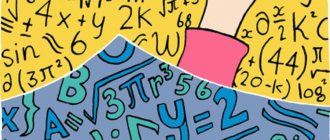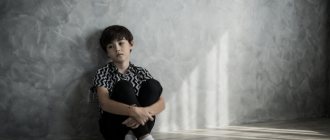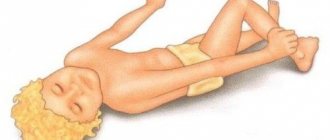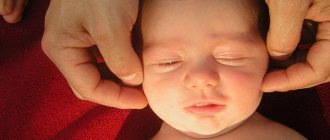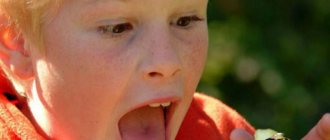Causes of alalia
The reasons that lead to the occurrence of alalia are very diverse. During specific periods of early ontogenesis they may be different. In the antenatal period, organic damage to the speech centers of the brain can be caused by fetal hypoxia, intrauterine infection, the threat of spontaneous abortion, and chronic somatic diseases of the pregnant woman.
A complicated pregnancy can lead to complications during childbirth and the occurrence of perinatal pathology. Alalia can be a consequence of premature, prolonged or rapid labor, asphyxia of the newborn, or the use of obstetric instruments.
Among the etiopathogenetic factors of alalia that affect the baby in the first years of life are meningitis, encephalitis, traumatic brain injury, and somatic diseases that lead to depletion of the central nervous system. Researchers also note a hereditary predisposition to alalia. Factors that aggravate the effect of certain causes of alalia are frequent illnesses of the child in the first years of life, operations performed under general anesthesia, and unfavorable social conditions. Usually, the history of small patients with alalia reveals the influence of a whole complex of factors.
Organic damage to the brain leads to a slowdown in the maturation of nerve cells. The result is a decrease in neuronal excitability, inertia of nervous processes and functional exhaustion of brain cells. In alalia, organic lesions of the cerebral cortex are mild but multiple in nature, so the possibilities for independent speech development are very limited.
Causes of sensory alalia in children
Sensory alalia is associated with damage to those areas of the brain that respond to the analysis of sounds and speech. To be more precise, the posterior third of the left hemisphere: it is projected onto the area behind the ear.
The disease is caused by:
- Pathology during pregnancy - intrauterine hypoxia, infections, immune attack, drug use, bad habits, harmful working conditions, intoxication;
- Damage to the central nervous system during childbirth: rapid labor, narrow pelvis, obstetric care. The consequence is traumatic brain injury. And protracted labor, entanglement of the umbilical cord, oligohydramnios, premature loss of water causes damage to brain cells due to insufficient oxygen supply - hypoxia;
- Pathology in the postpartum period and the first years of life - injuries, space-occupying formations, inflammatory and infectious diseases of the brain and meninges, intoxication, toxic damage to brain cells due to infectious diseases.
Most often, several factors influence a child. The cortical part of the auditory-speech analyzer is affected, and the process of recognizing sound stimuli is disrupted. The child hears speech, but cannot grasp its meaning and content. That is, he has not developed phonemic processes and does not have the skill of holistic speech perception.
As a result, the excitation (impulse) is not transmitted along the chain to other analyzers: speech-visual, speech-motor. Thus, the baby hears speech, but cannot perceive it, analyze it, and therefore does not react to it in any way.
Alalia classification
Over the entire period of studying the problem, several classifications of alalia have been proposed depending on its manifestation, mechanism, and severity of speech underdevelopment. Today in speech therapy the classification of alalia according to V.A. is used. Kovshikov. According to it, they distinguish:
- motor or expressive alalia;
- sensory or impressive alalia;
- mixed alalia (sensorimotor or motosensory, depending on the predominance of speech development disorders).
The motor form of alalia occurs as a result of early organic damage to the cortical part of the speech motor analyzer. In this case, the child does not develop his own speech, but his understanding of someone else’s speech is preserved. Depending on which area of the brain is damaged, there are 2 types of alalia - afferent motor and efferent motor. With afferent motor alalia, an organic lesion of the postcentral gyrus (lower parietal parts of the left hemisphere) is observed, which is accompanied by kinesthetic articulatory apraxia. With efferent motor alalia, damage to the premotor cortex (posterior third of the inferior frontal gyrus, Broca's center) occurs, accompanied by kinetic articulatory apraxia.
The sensory form of alalia occurs as a result of damage to the cortical part of the auditory-speech analyzer (posterior third of the superior temporal gyrus, Wernicke's center). In this case, the child’s higher cortical analysis, as well as the synthesis of speech sounds, is disrupted. Despite the fact that his physical hearing is preserved, the child does not understand the speech of those around him.
Expressive alalia
Expressive alalia is a language disorder that is characterized by a violation of the assimilation in the ontogenesis of expressive speech of the inventory of linguistic units and the rules of their functioning, which in the process of speech generation is manifested in the impossibility or in the disorder of the production of grammatical, lexical and phonemic operations with complete or relative preservation of semantic and motor ( articulatory) operations.
Expressive alalia is caused by organic lesions of the brain in the prenatal, natal or early postnatal periods. There is an opinion that most children with alalia have (or had in the early stages of their development) mild but multiple damage in both hemispheres of the brain.
The mechanism of alalia is still poorly understood. Representatives of different directions in the study of alalia agree that the disorder of the language mechanism is based on organic failure of the brain. At the same time, some researchers associate the disorder in the functioning of the language mechanism with pathology of motor skills, others with pathology of certain aspects of mental activity, and still others with selective failure in mastering language as a unique sign system. The last point of view is the most well-reasoned.
Alalia by a violation of all subsystems of the language: syntactic, morphological, lexical and phonemic. Typical manifestations of alalia are agrammatism, word search disorders, difficulties in “selecting” phonemes and establishing their order, and violations of the syllabic structure of words. Many children with alalia have a variety of non-linguistic disorders - neurological and psychopathological. The degree of language disorder in different children can be different and manifest itself within the boundaries from a complete (or almost complete) absence of expressive speech to minor deviations in the functioning of language subsystems: first (most severe), second (moderate) and third (mild) degrees of system impairment language (or, in the terminology of other authors, the first, second and third “levels of development (underdevelopment) of speech”).
During its development, alalia undergoes a number of quantitative and qualitative changes. Having mastered relatively simple units of language and the rules of their functioning, children for a long time experience difficulties in mastering more complex units and rules. Having mastered oral speech to a certain extent, they cannot fully master written speech for a long time.
The necessary criteria for determining expressive alalia are: 1) delay in the rate of normal language acquisition; 2) pathological development of language; 3) the presence at certain stages of ontogenesis, to varying degrees of severity, of violations of all subsystems of language; 4) preservation of hearing; 5) satisfactory understanding of spoken language accessible to a certain age.
It should be noted that expressive alalia can manifest itself in children with severe neurological and psychopathological disorders (for example, in children with cerebral palsy, in oligophrenic children, etc.). These variants of alalia are specific, have not yet been well studied and are difficult to diagnose. A very large number of different terms are used to refer to alalia, which reflects different ideas about it and insufficient knowledge of its etiology, mechanism and dynamics. The most common terms are “alalia idiopathic” (congenital), “hearing muteness”, “aphasia” (“dysphasia”), “developmental aphasia” (“ontogenetic aphasia”), “speech development delay” and “constitutional delay”, “general underdevelopment speech", "impaired language acquisition", "language inability". Examples of rarely used and uninformative terms: “muteness”, “congenital alogy”, “non-speaking children”, “children with severe (profound) speech impairments”. These terms carry an uncertain meaning and many fundamentally different forms of speech disorders can be subsumed under them.
Of the existing terms that best meet the requirements for a term as an element of the language of science, and which to a greater extent reflect the specifics of the designated object, are, from our point of view, the terms “alalia” and “developmental aphasia” (otherwise “ontogenetic aphasia"). Of the two terms used to designate the form of alalia, in which auditory perception and speech understanding are preserved, but expression and speaking are impaired, namely, from the terms “motor” and “expressive,” the latter seems more successful, since it captures the typical for This form of pathology of speech activity is a disorder of linguistic (speech) expression and at the same time the rigid attachment of this disorder to its mechanism, about which very little is still known, is removed.
Due to the fact that different authors put different content into the concept of expressive alalia and sometimes define the boundaries of alalia very broadly (i.e., they consider various variants of language development disorders to be alalia), there is currently no convincing statistical data on its distribution. However, the available data are scarce and contradictory.
If you still try to summarize them and find the average indicators, then with certain reservations we can assume that alalia is observed in 0.1% of the population. Moreover, this figure varies depending on age. Thus, among preschool children, those suffering from alalia account for approximately 1.0%. Among children of primary school age - 0.6%, middle and older - 0.2%. In relation to all forms of pathology of speech activity in all age groups, alalia is 0.5%, in children - approximately 4.0%. Alalia is more common in males; The ratio of the incidence of alalia between the sexes is 2:1. According to clinical observations, compared to impressive (sensory) alalia, expressive alalia is much more common (there are no exact statistics).
Symptoms of motor alalia
Motor alalia symptoms can have different symptoms - both speech and non-speech related (neurological, psychological).
Neurological symptoms in this form of alalia are represented, first of all, by motor disturbances, poor coordination, and poor development of finger motor skills. Children with motor alalia find it difficult to master even basic self-care skills (tying shoes, fastening buttons) and performing fine motor operations (folding puzzles, mosaics).
Giving a psychological description of children with motor alalia, it should be noted violations of attention, memory, and perception. Such children may be hyperactive or, conversely, inhibited and inactive. Children with motor alalia are characterized by high fatigue, decreased performance, and speech negativism. Motor alalia in children leads to the fact that, due to speech insufficiency, the child’s intellectual development suffers secondarily. However, as speech develops, it gradually returns to normal.
With motor alalia, there is a pronounced dissociation between impressive and expressive speech. Understanding of speech is preserved, but one’s own speech does not develop at all or develops with gross deviations. The stages of development of speech skills (namely: humming, babbling, words, phrases, coherent speech) are delayed, and the speech reactions themselves are very simplified.
Despite the fact that a child with afferent motor alalia is theoretically capable of performing any articulatory movements, he has severe disturbances in sound pronunciation. Often, in this case, confusion and persistent substitutions of articulatory disputable phonemes arise, which inevitably leads to the impossibility of reproducing the sound image of a word.
In the case of efferent motor alalia, the main speech defect is the inability to perform a series of successive articulatory movements, which is accompanied by a gross distortion of the syllabic structure of the word. Against the background of motor alalia, the unformed dynamic speech stereotype often leads to the appearance of stuttering.
The vocabulary in motor alalia is quite behind the age norm. The child learns all new words with difficulty; his speech contains mainly everyday terms. A small vocabulary leads to an inaccurate understanding of the meanings of words, their inappropriate use in speech, and substitution based on sound and semantic similarity. A distinctive feature of motor alalia is the predominance of nouns in the nominative case in speech, significant limitation of other parts of speech, difficulties with the formation and recognition of grammatical forms.
Coherent speech with motor alalia is severely impaired. It usually consists of short sentences. A child with speech alalia cannot consistently present events, separate the main from the secondary, convey the meaning of the event, determine cause and effect, and temporary connections.
In severe forms of motor alalia, speech does not develop at all; the child can only imitate sounds and pronounce individual babbling words, accompanying them with facial expressions and active gestures.
Symptoms of sensory alalia
The main defect in sensory alalia is a violation of the perception of addressed speech and understanding of its meaning. At the same time, sensory alaliks fully retain physical hearing. They often suffer from hyperacusis - excessive sensitivity to sounds that are indifferent to others (rustling, creaking).
The child’s own speech activity with sensory alalia is increased. But speech is a collection of meaningless sounds and fragments of words. Often, instead of answering a question, a child with sensory alalia repeats the question itself, i.e. other people's words. In this case, there is so-called echolalia. In general, speech with sensory alalia is meaningless, it is incoherent and incomprehensible to others. There is so-called logorrhea or “word salad”. In addition, in the speech of children with sensory alalia there are omissions of syllables (elision), obsessive repetitions of sounds and syllables (perseveration), combining parts of two words with each other (contamination), sound substitutions (paraphasia). At the same time, children with sensory alalia are very tolerant of their own speech; such a violation does not prevent them from communicating, because for this they use gestures and facial expressions.
In the case of a severe form of sensory alalia, the child’s understanding of speech is completely absent, but in other cases it depends on the situation. But even if the child understands the meaning of the phrase, then if you change the order of words in the sentence, the word form or the pace of speech, understanding is lost. Often, in order to comprehend speech, a child with sensory alalia has to “read” the lips of the speaker. There are children who understand only what they can say themselves, and in order to comprehend speech, they need to pronounce the words. Under other circumstances, they lack understanding.
Insufficient phonemic hearing leads to the fact that a child with sensory alalia does not distinguish between words that have different meanings, but are similar in sound, and also cannot correlate a spoken or heard word with a particular phenomenon or object.
Gross distortion of speech development can also lead to secondary personality disorders and delayed intellectual development. But categorical conclusions should not be drawn. A child’s failure to understand a speech task can easily be mistaken for mental retardation in sensory alalia.
As for the psychological characteristics of children with sensory alalia, they are characterized by increased distractibility, difficulty maintaining attention, instability of memory and auditory perception. Such children may exhibit chaotic behavior, impulsiveness, or, conversely, isolation and inertia. Sensory alalia in its pure form is quite rare. Most often, a mixed sensorimotor form occurs, which confirms the functional connection of the speech-auditory and speech-motor analyzers.
Sensory (impressive alalia). Symptoms and classification by severity.
In more severe cases, the child does not understand the speech of others at all, treats it as noise devoid of meaning, does not even react to his own name, does not differentiate between speech sounds and non-speech noises, and is indifferent to any speech and non-speech sound stimuli.
In other cases, the child understands individual everyday words, but loses their understanding against the background of a detailed statement. Sometimes understanding isolated words makes it much more difficult for a child to understand the meaning of a phrase. Catching not all the words and their shades in the address to him, the child gives the wrong reaction.
There are children who perform the required simple task relatively easily, but at the same time do not understand the words of the instruction outside of a specific situation, i.e. the general meaning of a phrase is perceived more easily than isolated words. Gradually, the child begins to listen to sounds, including speech, but his attention remains unstable and exhausted for a long time. Phonemic perception develops slowly and remains unformed for a long time.
The situation plays a big role for children with AS. Children often understand the content of statements only in a certain context. It is difficult for them to understand the meaning of words when the forms and order of words change; they do not perceive the meaning of grammatical structures.
In a number of cases, children do not understand slightly complicated tasks and do not distinguish what was said in error from the correct option. Some people do not understand speech when the tempo of the statement changes, they confuse words with the same type of accent-syllable structure, and perceive words that sound similar in sound as identical. Sometimes children ask to repeat speech addressed to them and understand only what is spoken several times, since a one-time stimulus turns out to be insufficient for perception. When the auditory stimulus is reinforced, the perception process improves.
Difficulties in switching on, switching and distributing attention are noted. The child does not immediately perceive the sound or speech addressed to him. Distracted by external stimuli even without them. Noteworthy is the slowness of auditory perception.
Having not understood something, a child can figure it out if the same thing is repeated several times unchanged or retold in different words. Sometimes it is difficult to recognize familiar words. There are children who understand only what they can say themselves, and understand only after such pronunciation. Speaking at the moment of perception leads to improved understanding, apparently because it is reinforced by kinesthesia from one’s own utterance. Children often look at the speaker's face. In this case, understanding is improved by reinforcing the auditory impression from the visual analyzer - reading from a face; inclusion of a visual stimulus in perception enhances acoustic impressions.
Sometimes a child understands only one person—the mother, the teacher—and does not understand when someone else says the same thing. In this case, the reaction to sounds does not depend on the volume of the sound.
In children with AS, in the absence of understanding, their own speech becomes impossible or grossly distorted. In severe cases, a speechless, incomprehensible child experiences motor restlessness and severe behavioral difficulties: the child plays, jumps, screams, knocks, and is chaotic in activity. But sometimes such children are affectionate, shy, and to some extent aware of their defect.
Children use gestures and facial expressions to communicate. They listen to music and are selective about their motives. Silence calms children, but loud conversations and shouting irritate them. They react correctly to changes in intonation, without understanding the words of address. The game is accompanied by modulated babble. Gradually, babbling develops into an active vocabulary, but words are pronounced distorted in sound and structure, understanding the meaning of words is difficult.
Gradually, the child begins to listen to the surrounding sounds, comprehend some of them, and relate them to certain phenomena of the surrounding life. As a reaction to the speech environment, a child with sensory impairment appears in fragments of words, emotional exclamations that are not directly related to the situation, but indicate his speech activity. Then, in the course of development, a situational, more stable understanding and use of individual words and simple phrases gradually appears. In babbling, individual words or their fragments, interjections, which are produced out of connection with the situation, are distinguished. The meaning of words spoken by a child is unstable. The presence of words in the active dictionary exceeds the passive dictionary.
When the sound and syllabic structure of words are distorted, numerous searches are noted; the child is not confident in his speech production, looking for adequate kinesthesia: elephant - “sleep”, “vylon”, “sylon”, “salon”, etc. Diffuse undifferentiated perception of sounds leads to undifferentiated pronunciation. Gradually, the child develops an awareness of mistakes: “No, I didn’t say that.”
Sometimes there is an incoherent reproduction of all the words known to the child - a kind of logorrhea, perseverations of heard or spoken words and phrases are noted; words that are perceived at a given time or perceived earlier are repeated - echolalia. Without catching the meaning, the child pronounces words and phrases like an echo. What is spoken echolally is not comprehended and is not consolidated.
The words contain numerous errors in stress, slippages from sounds, various sound substitutions, and distortions in the structure of words. In most cases, distortions and substitutions are not fixed in nature; with each new reproduction, the child allows a new variant of distortion. \…\
If they have their own speech, children with AS speak easily, smoothly, without tension, do not think about the exact expression of thoughts and the construction of sentences when choosing words, and do not notice the mistakes they have made. The speech production of children remains beyond their own control, inadequacy of what is expressed is encountered, words and phrases are pronounced that are not related to the situation, devoid of meaning. Fragmentation of speech is noted, but this is not due to the child’s motor difficulties, but to a small volume of perception, with difficulties in finding the correct version of the statement.
The child’s statements are inaccurate in content and erroneous in form; it is often difficult to understand what he is talking about so passionately and intonatedly. Pronunciation is characterized by approximateness; an abundance of paraphasias (substitutions), elision (omission of sounds, parts of words), perseverations, contaminations (part of one word is combined with part of another word) is revealed. In general, the speech of a child with AS can be characterized as increased speech activity against the background of decreased attention to the speech of others and lack of control over one’s own speech.
Grossly distorted speech in AS cannot be used by a child as a means of communication. Regardless of the degree of impairment in understanding and own speech, a child with AS has personality disorders; various behavioral difficulties, features of the emotional-volitional sphere, secondary mental retardation. Speech is not a regulator or self-regulator of the behavior and activities of such a child. Children with AS have limited abilities to organize role-playing play; it is often accompanied by incoherent pronunciation of undifferentiated sound complexes and inappropriately used words and phrases.
Children cannot listen for a long time when they are read or told. Without understanding the content, they lose interest and stop listening. The child learns new words and structures slowly. He is not critical of his speech, his behavior is chaotic, he acts impulsively.”
(“Speech therapy” edited by Volkova L.S., 2006; chapter 11 “Alalia” - B.M. Grinshpun, S.N. Shakhovskaya)
Examination of children with alalia
In each specific case, alalia proceeds in its own way. But to determine whether a child has serious speech problems, you should know the norms of speech development. As a rule, at 2 months the baby develops a characteristic hum, and at 3-4 months - babbling. The child should pronounce his first words at 6-8 months, and by the age of one year he should be able to construct entire phrases. If by the age of 2 the baby’s vocabulary is only a few words, his speech is incomprehensible and incoherent, then it’s time to sound the alarm and go to the doctor: perhaps the child has speech alalia. Detecting it at an early stage will have a beneficial effect on subsequent correction.
Children with alalia definitely need consultation from specialists such as a pediatric neurologist, otolaryngologist, speech therapist, and psychologist.
A neurological examination of a child with alalia is necessary in order to identify and assess the nature and extent of brain damage. In this case, the child may be recommended echoencephalography, EEG, MRI of the brain, and radiography of the skull. In order to exclude hearing loss in case of sensory alalia, it is necessary to conduct otoscopy, audiometry and other hearing tests.
A neuropsychological examination of a patient with alalia consists of diagnosing auditory-verbal memory. An examination by a speech therapist for alalia begins with clarifying the perinatal history, as well as the characteristics of the child’s early development. In this case, special attention should be paid to the timing of psychomotor and speech development. Diagnosis of a child’s oral speech with alalia (lexico-grammatical structure, impressive speech, phonetic-phonemic processes, articulatory motor skills) is carried out according to the examination scheme for general speech underdevelopment.
Differential diagnosis of alalia is carried out with dysarthria, hearing loss, mental retardation, and autism.
Signs of sensory alalia in children
The main symptom of sensory alalia is misunderstanding of addressed speech of varying degrees:
- Easy degree - children understand simple words that are often used in everyday life and in familiar situations. At the same time, if the same word is heard in an unfamiliar environment, they cease to understand it;
- The average degree is accompanied by more severe disorders. The number of words to which the child somehow reacts is minimal;
- In severe cases, children absolutely do not respond to speech and even to their name.
In this case, a characteristic symptom of sensory alalia is verbosity (logorrhea) - active speech, rich in sound combinations and interjections. Usually it is incomprehensible to others. Also, one of the signs of the disease is uncontrolled repetition of words (echolalia). But if you ask the baby to say this word, he will not be able to do this purposefully.
The child’s process of correlation between a phenomenon or object and the word that denotes it is disrupted. He places accents incorrectly, replaces letters, or skips them.
The voice is clear, hearing and intelligence are preserved. The baby quickly loses interest in activities and games, and has an unstable mood. In general, he is uncontrollable, impulsive, and even sometimes aggressive. As a result, it is difficult for him to build communication with others, and those around him avoid him.
Alalia correction
For children diagnosed with alalia, treatment consists of competent and gradual correction of the child’s speech skills. They receive the necessary help in specialized preschool educational institutions, correctional centers, hospitals, and sanatoriums.
Correction of alalia is carried out simultaneously with drug therapy, which is aimed at stimulating the maturation of brain structures, as well as physiotherapy (magnetotherapy, laser therapy, hydrotherapy, electrophoresis, electropuncture). With alalia, it is very important to work on the development of motor skills - manual and general, as well as mental functions (attention, memory, thinking).
Considering the fact that the violation is systemic in nature, classes to correct alalia involve working on all aspects of speech. In particular, with motor alalia in children, speech activity is stimulated, work is done on sound pronunciation, vocabulary formation, development of coherent speech, and grammatical design of statements. Speech therapy classes for alalia necessarily include speech therapy massage and logorhythmics.
With sensory alalia, first of all, the task is to learn to distinguish between non-speech and speech sounds, differentiate words, relate them to specific objects and actions, understand phrases and speech instructions, and master the grammatical structure of speech. Then, as the vocabulary accumulates, phonemic perception and subtle acoustic differentiations form, you can move on to the development of the baby’s own speech.
When correcting various forms of alalia, it is also recommended to teach children early literacy, because writing and reading help to better consolidate the learned material and control oral speech.
Forecast and prevention of alalia
The result of corrective work for alalia depends on many factors. In particular, the key to success is the early start of correction (from 3-4 years), its comprehensive nature, and the impact on all components of speech. An indispensable condition for successful correction of alalia is that the formation of speech processes must be carried out in the unity of all mental functions. For a child with motor alalia, the prognosis is more favorable. With sensory and sensorimotor alalia - rather indefinite. The prognosis is significantly influenced by the degree of organic brain damage. In the future, children with alalia may experience various impairments in written speech during their schooling. It is important to remember that corrective work for alalia helps prevent the occurrence of secondary intellectual disability.
As for the prevention of alalia, to prevent it it is necessary to ensure a favorable course of pregnancy and childbirth, as well as the early physical development of the child.
Complications of sensory alalia
Impaired sound perception leads to incorrect pronunciation and unformed expressive speech. An additional symptom of sensory alalia is general speech underdevelopment. It is difficult for such children to master school material due to disorders of learning skills - impaired writing and reading. They find it difficult to communicate with peers.
In later life, this causes signs of psychological disorders and emotional and volitional disorders. The intellect suffers and mental retardation develops. Children become unsociable, withdrawn, and live in their own little world.

